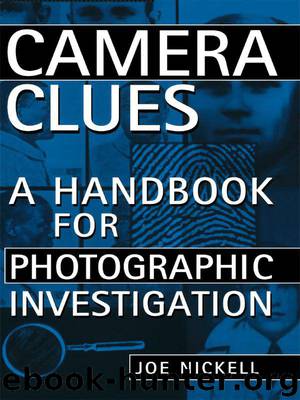Camera Clues: A Handbook for Photographic Investigation by Nickell Joe

Author:Nickell, Joe [Nickell, Joe]
Language: eng
Format: epub
Publisher: University Press of Kentucky
Published: 2010-09-29T04:00:00+00:00
Figure 6.2 (above). An excellent example of an early photomontage, created from two or possibly three photographic negatives, betrayed by the image of the water superimposed on the rocks. Figure 6.3 (below). Detail showing overlapping of image. (Courtesy Dept. of Special Collections, University of Kentucky M.I. King Library; Thomas House, photoarchivist.)
Photomontages. The term montage (French for “mounting,” from monter, “to mount”) has been used loosely to describe any process for making a single picture from two or more pictures closely arranged or superimposed. This includes all the methods discussed thus far—background projection, collage (termed “cut montage”), and sandwiching—and other techniques.9 (See Figures 6.2-6.5.)
However, at least one professional text uses “montage” to refer essentially to darkroom montage, a means of combining images from several photographs into a single image and commonly used in the nineteenth century. In modern advertising, photos are usually made specifically for the intended composite and so are photographed against a black background. The black serves as a “self-mask for the subject”; that is, when the composite is printed, only the subject exposes, the remainder of the picture area being masked or blocked from exposure by the black background.
To produce the montage, the objects may be placed against black velvet, lighted appropriately, and photographed. Then a “sized sketch” is made by placing the negative of the most important area in the enlarger, adjusting it to the desired size and position, and carefully tracing the general contour and most significant features; the process is repeated for each additional element. This serves as a guide for the final printing of each element onto a single piece of duplicating film or photographic paper. However, when elements of the picture cannot be “self-masked” as described above (when surrounded, for example, by a complicated background), special “element isolation masks” must be prepared. See Don and Marie Carroll’s Focus on Special Effects for detailed instructions.10
As an example of what can be accomplished by montage, a photograph of three galloping white horses (with an uninteresting, winter-bare background) was used with two others—one of mist and one of a red-sunset sky—which combined to give an impression of a forest fire. The resulting montage was an exciting—albeit faked—scene of the horses fleeing an apparently encroaching conflagration.11
Download
This site does not store any files on its server. We only index and link to content provided by other sites. Please contact the content providers to delete copyright contents if any and email us, we'll remove relevant links or contents immediately.
Shoot Sexy by Ryan Armbrust(17560)
Portrait Mastery in Black & White: Learn the Signature Style of a Legendary Photographer by Tim Kelly(16873)
Adobe Camera Raw For Digital Photographers Only by Rob Sheppard(16800)
Photographically Speaking: A Deeper Look at Creating Stronger Images (Eva Spring's Library) by David duChemin(16501)
Bombshells: Glamour Girls of a Lifetime by Sullivan Steve(13692)
Art Nude Photography Explained: How to Photograph and Understand Great Art Nude Images by Simon Walden(12855)
Perfect Rhythm by Jae(5076)
Pillow Thoughts by Courtney Peppernell(4022)
The Book of Joy by Dalai Lama(3704)
Good by S. Walden(3353)
The Pixar Touch by David A. Price(3220)
A Dictionary of Sociology by Unknown(2858)
Fantastic Beasts: The Crimes of Grindelwald by J. K. Rowling(2849)
Stacked Decks by The Rotenberg Collection(2692)
Humans of New York by Brandon Stanton(2690)
Read This If You Want to Take Great Photographs by Carroll Henry(2604)
On Photography by Susan Sontag(2489)
Photographic Guide to the Birds of Indonesia by Strange Morten;(2408)
Insomniac City by Bill Hayes(2399)
